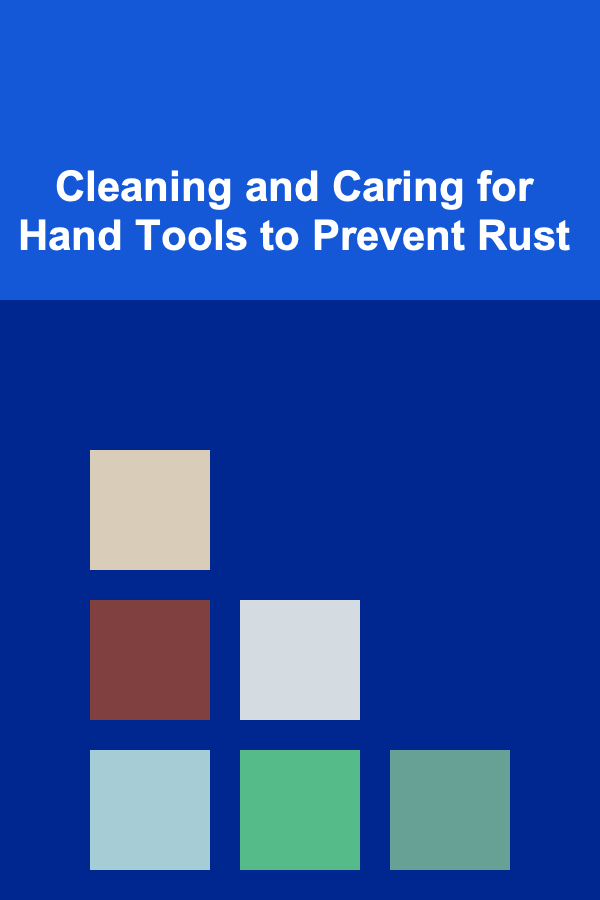
Cleaning and Caring for Hand Tools to Prevent Rust
ebook include PDF & Audio bundle (Micro Guide)
$12.99$7.99
Limited Time Offer! Order within the next:

Hand tools are the backbone of countless projects, from simple home repairs to complex construction endeavors. Their reliability and precision depend not only on their initial quality but also on the care and maintenance they receive. Rust, a relentless enemy of metal, can significantly diminish the performance and lifespan of your cherished tools. Preventing rust isn't just about aesthetics; it's about preserving your investment, ensuring accurate work, and maintaining safety. This comprehensive guide delves into the art and science of cleaning and caring for your hand tools to effectively combat rust and keep them in optimal condition for years to come.
Understanding Rust Formation
Before diving into cleaning and prevention techniques, it's crucial to understand the fundamental processes that lead to rust formation. Rust, scientifically known as iron oxide, is a chemical reaction between iron (the primary component of most hand tools), oxygen, and water (or moisture). This electrochemical process is accelerated by the presence of electrolytes like salt, acids, and pollutants in the environment. Here's a breakdown of the key elements involved:
- Iron: The base metal of most hand tools. The iron atoms are susceptible to oxidation.
- Oxygen: Oxygen in the air acts as the oxidizing agent, reacting with the iron.
- Water (or Moisture): Water acts as the electrolyte, facilitating the electron transfer necessary for the oxidation reaction. Humidity alone can provide sufficient moisture for rust to begin forming.
- Electrolytes (Salt, Acids, Pollutants): These substances accelerate the rusting process by increasing the conductivity of the water, allowing for faster electron transfer. Saltwater is a particularly potent rust accelerator.
Understanding these factors allows you to tailor your cleaning and prevention strategies more effectively. For example, if you live in a coastal area with high salt content in the air, you'll need to be more diligent in your rust prevention efforts than someone living in a dry, inland climate.
The Importance of Regular Cleaning
Regular cleaning is the first line of defense against rust. It removes contaminants that can accelerate the rusting process, such as dirt, grime, grease, and moisture. Cleaning also allows you to inspect your tools for early signs of rust so you can address them before they become a major problem. The frequency of cleaning will depend on how often you use your tools and the environment in which they are stored and used.
Essential Cleaning Supplies:
- Stiff-bristled brushes: For scrubbing away dirt and grime. Choose brushes with different bristle materials (nylon, brass, steel) depending on the tool and the severity of the dirt. A toothbrush is excellent for detailed cleaning.
- Clean rags or microfiber cloths: For wiping down tools and applying protectants.
- Warm soapy water: A mild detergent like dish soap is effective for removing grease and grime.
- Solvent-based cleaner: For removing stubborn grease, oil, or paint. Mineral spirits, WD-40, or commercial degreasers can be used. Use in a well-ventilated area and wear appropriate safety gear.
- Rust remover: For dealing with existing rust. Options include chemical rust removers (phosphoric acid-based), vinegar, and abrasive methods.
- Protective gloves: To protect your hands from harsh chemicals and sharp edges.
- Safety glasses: To protect your eyes from splashes and debris.
General Cleaning Procedure:
- Inspect the tool: Identify areas with dirt, grime, or rust.
- Remove loose debris: Use a brush or compressed air to remove loose dirt, sawdust, or metal shavings.
- Wash with warm soapy water: Scrub the tool with a brush and soapy water to remove grease and grime. Rinse thoroughly.
- Dry completely: Use a clean rag or microfiber cloth to dry the tool thoroughly. Pay attention to crevices and joints where moisture can linger. You can also use compressed air to expedite the drying process.
- Apply a rust preventative: Once the tool is dry, apply a thin coat of rust preventative (see section on rust preventatives below).
Removing Existing Rust
Despite your best efforts, rust may still appear on your tools. The key is to address it promptly to prevent it from spreading and causing further damage. There are several methods for removing rust, each with its own advantages and disadvantages.
Mechanical Rust Removal:
Mechanical methods involve physically removing the rust using abrasive tools. These methods are generally effective for removing heavy rust but can also scratch the underlying metal if not used carefully.
- Wire Brush: A wire brush is a simple and effective tool for removing loose rust. Use a brass wire brush for softer metals to avoid scratching. Steel wire brushes are more aggressive and should be used on harder metals.
- Sandpaper: Sandpaper can be used to remove rust, starting with a coarse grit (e.g., 80-grit) and gradually moving to finer grits (e.g., 220-grit) to smooth the surface.
- Steel Wool: Steel wool is effective for removing light rust and polishing metal surfaces. Use fine-grade steel wool (0000 grade) to avoid scratching.
- Grinding Wheel or Angle Grinder: These power tools are effective for removing heavy rust but require caution and skill. Use appropriate safety gear, including eye protection and gloves. Be careful not to remove too much metal.
- Rust Eraser: Rubber bonded abrasive blocks, sometimes called rust erasers, are gentler than sandpaper and good for small areas and delicate tools.
Important Considerations for Mechanical Rust Removal:
- Always wear safety glasses and gloves.
- Work in a well-ventilated area, especially when using power tools.
- Start with the least aggressive method and gradually increase the abrasiveness as needed.
- Be careful not to remove too much metal, especially on precision tools.
- After removing the rust, thoroughly clean the tool and apply a rust preventative.
Chemical Rust Removal:
Chemical rust removers use acids or other chemicals to dissolve the rust. These methods are generally less abrasive than mechanical methods and are suitable for removing rust from intricate parts and hard-to-reach areas.
- Vinegar: Vinegar (acetic acid) is a mild rust remover that is safe and readily available. Soak the rusted tool in vinegar for several hours or overnight. Then, scrub with a brush to remove the loosened rust. Rinse thoroughly and dry completely.
- Citric Acid: Citric acid is another mild and effective rust remover. Mix citric acid powder with water (e.g., 1 tablespoon per cup of water) and soak the rusted tool in the solution for several hours or overnight. Scrub with a brush, rinse, and dry.
- Phosphoric Acid-Based Rust Removers: Commercial rust removers containing phosphoric acid are more potent than vinegar or citric acid. Follow the manufacturer's instructions carefully. These products typically require soaking the rusted tool and then scrubbing with a brush. Phosphoric acid can leave a phosphate coating that helps prevent future rust. Wear gloves and eye protection when using these products.
- Evapo-Rust: This is a popular non-toxic, biodegradable rust remover that works through a process called chelation. It's very effective on heavily rusted items and is safe to use on a variety of metals.
Important Considerations for Chemical Rust Removal:
- Always wear gloves and eye protection when using chemical rust removers.
- Work in a well-ventilated area.
- Follow the manufacturer's instructions carefully.
- Some chemical rust removers can damage certain metals or finishes. Test the product on an inconspicuous area first.
- Rinse the tool thoroughly after removing the rust to neutralize any remaining chemicals.
- Dry the tool completely and apply a rust preventative.
Electrolysis Rust Removal:
Electrolysis is a more advanced rust removal technique that uses an electric current to remove rust. It's particularly effective for heavily rusted items with intricate shapes. It involves setting up an electrolytic cell with the rusted tool as the cathode (negative electrode), a sacrificial anode (usually a piece of steel), and an electrolyte solution (washing soda dissolved in water). A DC power source is connected to the electrodes, and the electric current causes the rust to be converted back to iron and deposit on the anode. This method requires some technical knowledge and proper safety precautions.
Important Considerations for Electrolysis Rust Removal:
- This method requires a DC power source, a container, a sacrificial anode, and washing soda.
- Ensure adequate ventilation as hydrogen gas is produced during the process (hydrogen is flammable).
- Always wear gloves and eye protection.
- Properly dispose of the electrolyte solution after use.
Rust Preventatives: Your Tools' Shield
After cleaning and removing rust, the final step is to apply a rust preventative to protect your tools from future corrosion. There are various types of rust preventatives available, each with its own properties and applications.
Types of Rust Preventatives:
- Oils:
- Mineral Oil: A light, non-drying oil that provides a good barrier against moisture. It's suitable for general-purpose rust prevention and is food-safe, making it a good choice for tools used in food preparation.
- Penetrating Oil (e.g., WD-40): While primarily used for loosening rusted parts, penetrating oil can also provide some rust protection. However, it tends to evaporate over time and may not be the best long-term solution.
- Gun Oil: Designed for firearms, gun oil provides excellent rust protection and lubrication. It's a good choice for tools that are exposed to harsh conditions.
- Waxes:
- Paste Wax: Provides a durable, water-resistant coating that protects against rust. It's suitable for tools that are frequently handled.
- Microcrystalline Wax: A high-quality wax that provides excellent rust protection and is often used on antique tools and firearms.
- Greases:
- Lithium Grease: A versatile grease that provides good lubrication and rust protection. It's suitable for tools with moving parts, such as gears and hinges.
- Waterproof Grease: Designed to resist water washout, waterproof grease is ideal for tools that are exposed to wet conditions.
- Rust Inhibitors:
- VCI (Vapor Corrosion Inhibitor) Emitters: These products release a vapor that inhibits corrosion on metal surfaces. They're often used in toolboxes and storage containers to protect tools from rust. VCI emitters are especially useful in enclosed spaces.
- Rust-Inhibiting Coatings: These are paints or clear coatings that form a barrier against moisture and oxygen. They can provide long-term rust protection but may alter the appearance of the tool.
Applying Rust Preventatives:
- Ensure the tool is clean and dry.
- Apply a thin, even coat of the chosen rust preventative. Use a clean rag or brush to apply the preventative.
- Wipe off any excess preventative. A thin coat is sufficient to provide protection. Excess preventative can attract dirt and grime.
- For tools with moving parts, apply grease or oil to the moving parts.
Proper Storage: A Rust-Free Haven
Even with diligent cleaning and rust prevention, improper storage can undo all your hard work. Creating a rust-free storage environment is crucial for long-term tool preservation.
Key Principles of Proper Tool Storage:
- Keep tools dry: Store tools in a dry environment to prevent moisture from condensing on the metal surfaces. Avoid storing tools in damp basements or garages.
- Control humidity: Use a dehumidifier in your storage area to maintain a low humidity level. Desiccant packs (silica gel) can also be used to absorb moisture in toolboxes and drawers.
- Avoid temperature fluctuations: Rapid temperature changes can cause condensation to form on tools, leading to rust. Store tools in a location with a stable temperature.
- Separate tools: Avoid storing tools in direct contact with each other, as this can create friction and damage the protective coating. Use tool organizers, drawers, or individual sleeves to keep tools separated.
- Store tools vertically: Storing tools vertically allows air to circulate around them, promoting drying and preventing moisture buildup. Tool racks and pegboards are excellent for vertical storage.
- Use protective sleeves or wraps: Wrap tools in oil-impregnated cloth or VCI paper to provide an extra layer of rust protection.
- Keep tools clean: Before storing tools, make sure they are clean and dry. Remove any dirt, grime, or moisture.
- Consider sealed containers: For particularly valuable or sensitive tools, consider storing them in airtight containers with desiccant packs.
Storage Options:
- Toolbox: A toolbox is a basic but essential storage solution. Choose a toolbox with a tight-fitting lid to keep out moisture and dust. Line the toolbox with foam or rubber to protect tools from damage.
- Tool Chest: A tool chest provides more storage space and organization than a toolbox. It typically has drawers, shelves, and compartments for different types of tools.
- Tool Cabinet: A tool cabinet is a larger, more robust storage solution that is often mounted on wheels. It provides ample storage space and is ideal for workshops and garages.
- Pegboard: A pegboard is a versatile storage solution that allows you to hang tools on hooks. It's a good way to keep tools organized and easily accessible.
- Wall-Mounted Racks: Wall-mounted racks are ideal for storing long-handled tools, such as shovels, rakes, and brooms.
- Drawer Organizers: Drawer organizers help you keep your tools neatly organized in drawers. They come in various shapes and sizes to accommodate different types of tools.
Special Considerations for Specific Tools
While the general principles of cleaning and rust prevention apply to all hand tools, some tools require special attention due to their construction or materials.
- Tools with Wooden Handles: Wooden handles can absorb moisture, leading to rust on the metal parts of the tool. Periodically treat wooden handles with linseed oil or beeswax to protect them from moisture and prevent them from drying out and cracking. Avoid storing tools with wooden handles in excessively humid environments.
- Precision Tools (e.g., Calipers, Micrometers): Precision tools require careful cleaning and lubrication to maintain their accuracy. Use a lint-free cloth and light oil to clean these tools. Store them in their original cases to protect them from damage and dust.
- Cutting Tools (e.g., Chisels, Knives): Cutting tools should be sharpened regularly to maintain their performance. Apply a thin coat of oil to the blade after sharpening to prevent rust. Store cutting tools in sheaths or protective sleeves to prevent accidental cuts.
- Plated Tools (e.g., Chrome-Plated Wrenches): Chrome plating provides some rust protection, but it can be damaged by scratches and abrasions. Clean plated tools with a mild detergent and water. Avoid using abrasive cleaners or wire brushes on plated surfaces. If the plating is damaged, apply a rust preventative to the exposed metal.
- Tools with Moving Parts (e.g., Pliers, Adjustable Wrenches): Tools with moving parts require regular lubrication to prevent rust and ensure smooth operation. Apply oil or grease to the moving parts and work the tool to distribute the lubricant.
Proactive Maintenance: The Long Game
The most effective approach to rust prevention is proactive maintenance. This involves incorporating cleaning and preventative measures into your routine workflow rather than waiting for rust to appear. Here are some tips for proactive tool maintenance:
- Wipe down tools after each use: Before putting a tool away, wipe it down with a clean rag to remove any dirt, grime, or moisture.
- Apply rust preventative regularly: Reapply rust preventative every few weeks or months, depending on the environment and the tool's usage.
- Inspect tools periodically: Take the time to inspect your tools regularly for signs of rust or damage. Address any problems promptly.
- Sharpen cutting tools regularly: Sharp tools are safer and more efficient. Keep your cutting tools sharp and well-maintained.
- Lubricate moving parts: Lubricate the moving parts of your tools regularly to prevent rust and ensure smooth operation.
- Store tools properly: Always store your tools in a dry, organized, and secure location.
- Educate yourself: Continue to learn about rust prevention techniques and best practices for tool care. New products and methods are constantly being developed.
Conclusion
Preventing rust on your hand tools is an ongoing process that requires diligence, knowledge, and the right tools and techniques. By understanding the causes of rust, implementing regular cleaning routines, removing rust effectively, applying appropriate rust preventatives, and practicing proper storage methods, you can significantly extend the lifespan of your tools and maintain their performance for years to come. Remember that proactive maintenance is the key to long-term tool preservation. Invest the time and effort in caring for your tools, and they will reward you with reliable service and accurate results for many projects to come. Don't underestimate the value of a well-maintained tool collection -- it's an investment in your craftsmanship and your future projects.
Reading More From Our Other Websites
- [Hiking with Kids Tip 101] Eco-Friendly Scavenger Hunts: Teaching Kids About Nature While They Play
- [Home Rental Property 101] How to Handle Rental Property Evictions with Care
- [Home Storage Solution 101] How to Choose the Right Storage Boxes with Lids: A Material and Size Guide for Every Room
- [Home Holiday Decoration 101] How to Transform Your Living Room with Festive Holiday Movie Marathon Decor
- [Home Space Saving 101] How to Design a Small Living Room with a Space-Saving TV Stand
- [Personal Care Tips 101] How to Use Dry Shampoo to Add Texture to Fine Hair for Better Styling
- [Personal Financial Planning 101] How to Manage Your Finances After a Divorce
- [Personal Finance Management 101] How to Save Money While Paying for College or Education
- [Home Staging 101] How to Use Furniture Placement for Effective Home Staging
- [Home Party Planning 101] How to Plan a Garden BBQ Party at Home

How to Create an Accessible Seasonal Clothing Rotation
Read More
How to Stage a Home with Bold Colors Without Overwhelming
Read More
How to Find Free Community Events
Read More
Forgiveness and Letting Go in Relationships: A Deep Dive
Read More
10 Tips for Reviewing and Adapting Your Personal Development Planner
Read More
How to Choose the Right Project Timeline Software for Small Teams
Read MoreOther Products

How to Create an Accessible Seasonal Clothing Rotation
Read More
How to Stage a Home with Bold Colors Without Overwhelming
Read More
How to Find Free Community Events
Read More
Forgiveness and Letting Go in Relationships: A Deep Dive
Read More
10 Tips for Reviewing and Adapting Your Personal Development Planner
Read More